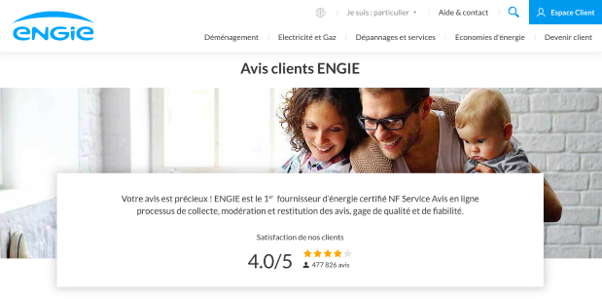ENGIE
Improving Customer Satisfaction through Voice of Customer Analytics
Looking at how to improve Customer Satisfaction and reduce attrition in the energy sector? Engie did just that, thanks to Proxem’s Semantic Analysis of multi-source customer verbatim.
Solution
The context: Engie, a success story in Customer Experience management
Engie is a leader in the energy sector, known for the supply of gas but also electricity to individuals, professionals and communities.
What is less known about Engie is that it has been mobilizing around the Customer Experience for years and has worked hard to put it at the heart of its business project.
Some examples?
Engie was the first energy supplier to publish customer reviews on its website, and in 2013 it became the first company to obtain the NF Services certification by AFNOR, a certification that guarantees the accuracy of online reviews.

Each year, more than 500,000 customer opinions are collected via satisfaction surveys and posted on Engie’s website in the Esprit Services section. Added to this are other sources of customer insights from ad hoc surveys distributed by the research department, as well as spontaneous feedback (social networks …)
The need:
Understanding the drivers of customer satisfaction and dissatisfaction to create action plans
Being able to analyze customer verbatim is essential to enabling us to understand why a customer is satisfied or dissatisfied in order to act and re-engage the customer.
Jean-Rémy Dudragne is the Customer Experience and Innovation Manager within the Engie branch in charge of the sale of electricity, natural gas and related services to individual customers in France. He leads four teams to identify how Engie can deliver the best customer experience to their users and drives improvement projects across the company.
It was with the goal of understanding the possible levers for optimizing the Customer Experience and for decreasing attrition that he launched, in 2017 a Call for Tender to equip Engie with a Semantic Analysis Software solution.
It was important to have a multi-source customer verbatim analysis solution because data was coming from a variety of touch points: service surveys, incoming channels, the website, end of service etc.
Through the various surveys used to analyze the entire customer journey, we wanted to classify the verbatim according to the stages of the journey and the typologies of irritants.
Why Proxem?: intelligent features and reliable Semantic Analysis
Following the Call for Tender process, Proxem was selected for two main reasons:
-
Functionalities
Proxem Studio analytics and data visualization capabilities appealed to the teams as they enable a much richer data analysis than traditional classification solutions. The possibility of having a single classification plan for all sources was also a criterion of choice.
-
Reliability of the classification and analysis
Most Semantic Analysis Software solutions are black boxes, and it is often frustrating to not be able to improve the quality of the analysis and the classification. The Engie team wanted to maximize the number of annotated comments (the coverage rate), and to have a ranking as relevant as possible. Only Proxem proposed a tool for evaluating the quality of the classification of verbatim: the F score.
Results
The results: Improved overall customer satisfaction
The analysis of multi-channel customer verbatim using Proxem Studio enabled Engie to:
- Save time by automating verbatim processing and analysis;
- Identify risks and highlight weak signals;
- Identify the levers of satisfaction and dissatisfaction distributed by typology of customers;
- Share the main irritants from each step of the customer’s journey.
We were able to democratize and identify the main irritants of the experience by the customer, on each of the reference courses. We understood how we could also be more relevant in the implementation of the actions. Proxem Studio has allowed us to improve our overall customer satisfaction by adapting the Engie offer.
What next?
Engie’s efforts to better capitalize on the Voice of the Customer are not over.
The next step is to process data from phone conversations using speech to text and analyze customer reviews on social networks through daily web monitoring.


